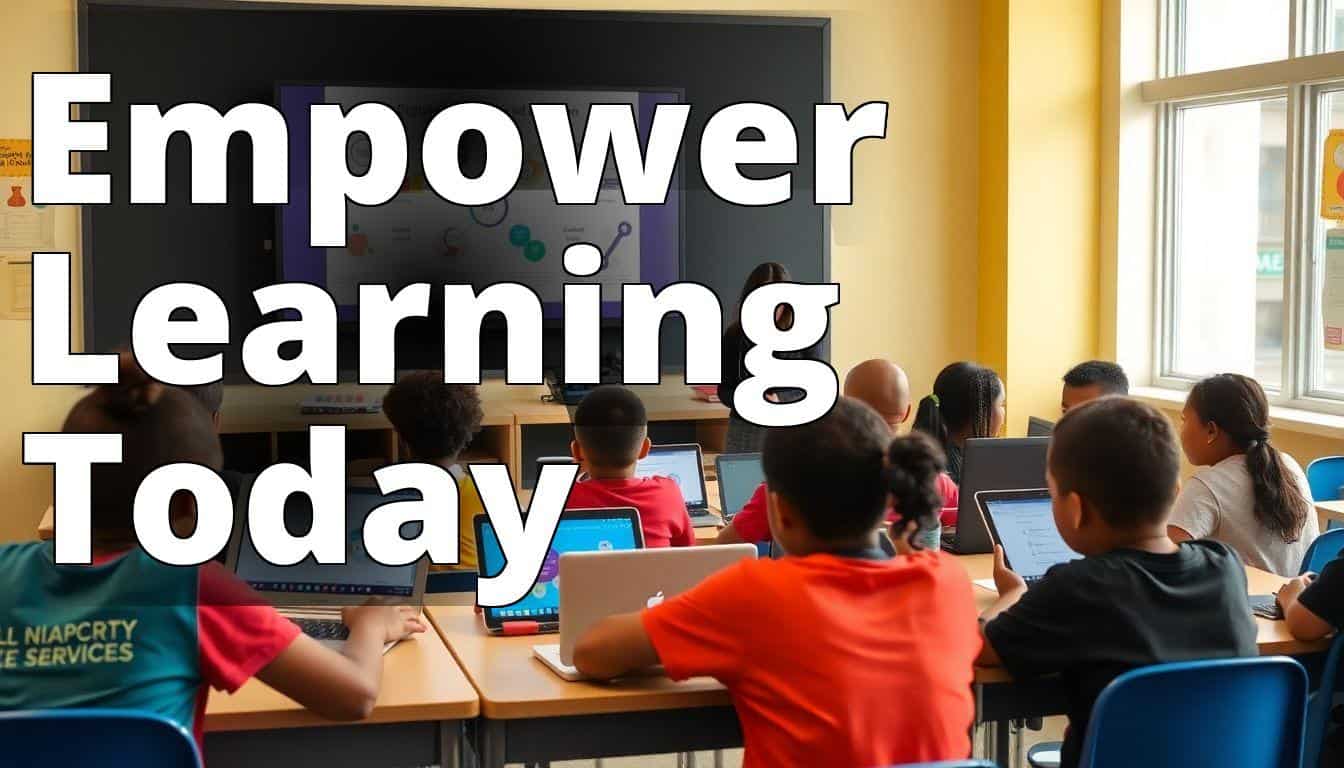Table of Contents
The digital divide is a glaring chasm that threatens the equitable development of our society, particularly in education. It exists not just as a gap in technology access but as a formidable barrier that underscores a broader opportunity gap. This divide is not just an issue of who has devices and who doesn’t; it is a reflection of deeper socioeconomic disparities that affect students’ educational outcomes and future opportunities. This article seeks to explore the intricacies of the digital divide, its far-reaching consequences, and practical measures for bridging this gap to promote technology equity in today’s classrooms.
Learn About Digital Equity
Discover essential insights on promoting technology equity in education and bridging the digital divide. – The digital divide refers to the gap between those with access to technology and those without, impacting educational opportunities. – Digital equity ensures all students have equal access to technology, while digital inclusion focuses on integrating technology into learning environments. – Five practical steps to enhance digital equity include assessing current needs, planning improvements, providing devices and internet access, and teaching digital literacy skills.
What Is the Digital Divide?
The digital divide is a term that has been thrown around in educational circles for decades, yet its implications are more profound than ever. At its core, the digital divide refers to the gap between those who have easy access to digital technology and those who do not. This includes not just hardware like laptops or tablets, but also internet connectivity and the skills to use these technologies effectively. The divide is prominent in many dimensions economic, geographical, and educational.
From personal experience, I recall the stark contrast between schools in affluent neighborhoods equipped with the latest gadgets and those in underfunded districts where a computer lab was a luxury. This divide is not just a statistical reality but a lived experience for many educators and students. The implications are manifold students without access to digital tools are at a significant disadvantage in an increasingly digital learning environment.
According to the Pew Research Center, approximately 15% of U.S. households with school-age children do not have high-speed internet connection at home, a gap that disproportionately affects low-income families and those in rural areas. This statistic underscores the urgency of addressing the digital divide as a critical educational issue.
What Is Digital Equity?
Digital equity goes beyond mere access to technology. It encompasses the fair distribution of digital resources, opportunities, and skills necessary to thrive in a digital world. Digital equity means that all students have the capability to use digital tools to bolster their education and future career prospects.
During a recent educational technology conference, I was struck by a speaker who emphasized that digital equity is not about giving every student a laptop but about ensuring every student can leverage technology to its fullest potential. This means providing robust support systems, such as training teachers, developing inclusive digital curricula, and tailoring technology to meet diverse learning needs.
Insider Tip: “Digital equity is achieved not when everyone has the same technology, but when everyone has the technology that suits their educational needs,” says Dr. Emily Chen, a leading researcher in educational technology.
The pursuit of digital equity requires a nuanced understanding of students’ diverse backgrounds and needs, which can be informed through comprehensive assessments and community engagement. To truly achieve digital equity, schools must foster environments where technology becomes a tool for empowerment rather than a barrier.
What Is Digital Inclusion?
Digital inclusion refers to the efforts made to ensure individuals and communities have access to digital tools and the skills to use them. It is a crucial component of achieving digital equity. Digital inclusion involves providing accessible, affordable internet and devices, as well as education and support to help people use technology effectively.
In my teaching career, I’ve witnessed firsthand how digital inclusion efforts can transform a student’s educational experience. When schools provide not only the devices but also the training and support to use them, students begin to see technology as an ally rather than an obstacle. Digital inclusion is about creating a supportive learning environment where every student can thrive.
The National Digital Inclusion Alliance defines digital inclusion as having five components: affordable, robust internet service; internet-enabled devices that meet the needs of the user; access to digital literacy training; quality technical support; and applications and online content designed to enable and encourage self-sufficiency, participation, and collaboration.
The Importance of Digital Equity in Education
Digital equity is crucial for fostering an inclusive educational environment where all students can excel. In today’s classrooms, technology is not just an adjunct to education it is integral. From virtual classrooms to digital homework assignments, technology is woven into the fabric of learning. Therefore, ensuring digital equity is paramount to providing all students with equal educational opportunities.
Reflecting on my experience as an educator, I’ve seen how unequal access to technology can widen the achievement gap. Students without reliable internet or digital devices often fall behind their peers, not because they lack ability, but because they lack resources. This is not just a technology issue; it is a social justice issue.
Insider Tip: “Educators need to advocate for policies that support digital equity as a fundamental right,” suggests Dr. Rebecca Martinez, an advocate for educational reform.
Digital equity is not just about leveling the playing field; it’s about redefining it. By ensuring all students have access to the tools and skills they need, we empower them to innovate, create, and contribute to the digital economy.
The Digital Divide and the Homework Gap
The homework gap is a direct consequence of the digital divide, where students without adequate internet access at home struggle to complete assignments that require online resources. This gap is a significant concern for educators and policymakers, as it directly affects students’ academic performance and engagement.
I recall a poignant moment when a student confided in me about their struggles to complete homework on time due to lack of internet access at home. This is not an isolated issue but a widespread challenge that many students face. The homework gap is a daily reminder of the disparities that exist in our education system.
Research by the American Community Survey highlights that nearly 17% of students do not have adequate internet access at home, leading to the infamous homework gap. This gap disproportionately affects students from low-income families and rural areas, creating barriers to educational success and perpetuating inequality.
The Digital Divide and the Opportunity Gap
The digital divide contributes significantly to the opportunity gap, where unequal access to technology limits students’ educational and career prospects. In a world where digital literacy is increasingly linked to employ-ability, the consequences of this divide are profound.
Reflecting on my career, I’ve seen students who, despite their potential, were unable to pursue certain paths simply due to lack of access to technology. This is a systemic issue that requires systemic solutions. Addressing the digital divide is not just about providing technology but about creating opportunities for all students to succeed.
Insider Tip: “Closing the digital divide is essential to ensuring all students have the opportunity to succeed in a digital world,” emphasizes Dr. John Hargrove, an expert in educational policy.
The opportunity gap is not just a future issue but a present challenge. By bridging the digital divide, we can open doors for all students to explore and excel in the digital age.
Bridging the Digital Divide: 5 Ways to Promote Technology Equity in Your School or District
Addressing the digital divide requires concerted efforts and strategic planning. Here are five actionable steps that schools and districts can take to promote technology equity.
1. Assess your current state of digital equity.
Begin by evaluating the current state of digital equity in your school or district. This involves gathering data on technology access, internet connectivity, and digital skills among students and teachers. Conduct surveys, hold focus groups, and engage with the community to understand the specific needs and challenges faced by your students.
In practice, I’ve found that involving parents and community stakeholders in this assessment process provides valuable insights. Understanding the digital landscape is the first step in creating targeted interventions that address the unique needs of your school community.
2. Create a plan to improve digital equity.
Once you have a clear understanding of the current state, develop a comprehensive plan to improve digital equity. This plan should include goals, strategies, and measurable outcomes. Engage all stakeholders, including teachers, parents, students, and community leaders, in the planning process to ensure buy-in and sustainability.
In my experience, successful plans are those that are flexible and adaptable, allowing for adjustments as needs and circumstances change. Collaboration and communication are key to developing a plan that truly meets the needs of your community.
3. Provide students with devices.
Ensuring that all students have access to devices is a critical component of bridging the digital divide. Consider implementing a one-to-one device program, where each student is provided with a laptop or tablet for educational use. Explore partnerships with businesses and organizations to secure funding and resources for device acquisition.
In one memorable initiative I was part of, a school partnered with a local tech company to provide refurbished laptops to students, significantly improving access and engagement. Creative solutions and partnerships can make device distribution more feasible and sustainable.
4. Provide students with internet access.
Access to reliable internet connectivity is essential for students to fully participate in digital learning. Schools can partner with internet service providers to offer discounted or free internet plans for low-income families. Additionally, schools can provide Wi-Fi hotspots for students to use at home.
In a successful case study, a school district implemented a program that provided portable Wi-Fi hotspots to students without home internet access, effectively closing the homework gap. Ensuring internet access is a critical step in promoting digital equity.
5. Teach digital literacy skills.
Digital literacy is a crucial component of technology equity. Schools must provide students with the skills and knowledge to navigate and utilize digital tools effectively. This includes teaching critical thinking, information literacy, and digital citizenship.
Reflecting on my own teaching, I’ve seen the transformative power of digital literacy education. Students who are equipped with these skills are more confident, engaged, and prepared for the demands of the digital age.
Insider Tip: “Digital literacy is not just about using technology; it’s about understanding and leveraging it to achieve educational and personal goals,” advises Dr. Lisa Reynolds, a digital education specialist.
The Future of Technology Equity in Education
Looking ahead, the future of technology equity in education is promising yet challenging. As technology continues to evolve, so too must our approaches to ensuring equitable access and opportunities for all students. This requires ongoing commitment, innovation, and collaboration among educators, policymakers, and communities.
Investing in technology equity is an investment in our future. By bridging the digital divide, we empower the next generation to thrive in a digital world, fostering a more inclusive and equitable society. As we move forward, let us commit to creating a future where every student, regardless of their background, has the opportunity to succeed.
In conclusion, bridging the digital divide is not just an educational imperative but a moral one. By promoting technology equity in today’s classrooms, we can create a more just and equitable society where all students have the opportunity to succeed in a digital world. Let us continue to work together to ensure that every student has the tools, skills, and opportunities they need to thrive.
Questions and Answers
What is bridging the digital divide in education?
Bridging the digital divide means ensuring all students access technology.
Who benefits from technology equity in classrooms?
All students, particularly those in underserved communities, benefit greatly.
How can schools promote technology equity effectively?
Schools can promote equity by providing resources and training for all.
Why is technology equity important in today’s classrooms?
Technology equity is crucial for equal educational opportunities for everyone.
What challenges do educators face in achieving technology equity?
Educators often face funding issues and varying levels of tech access.
How can parents support bridging the digital divide at home?
Parents can advocate for resources and engage in their child’s learning.




